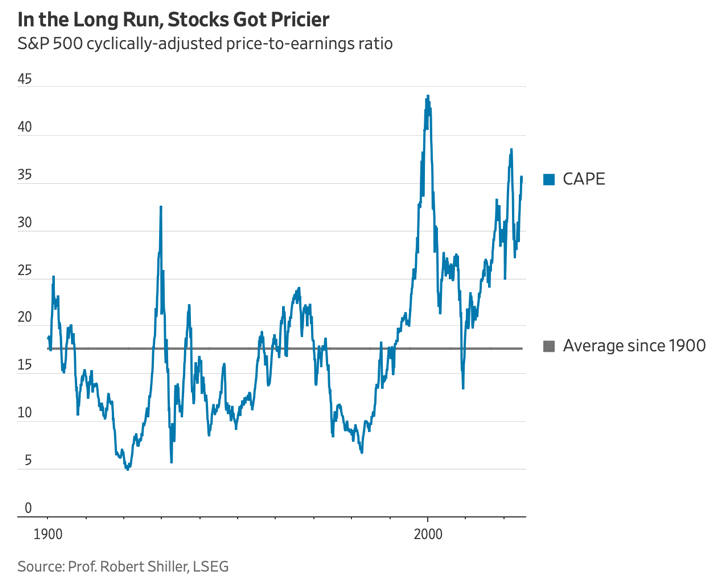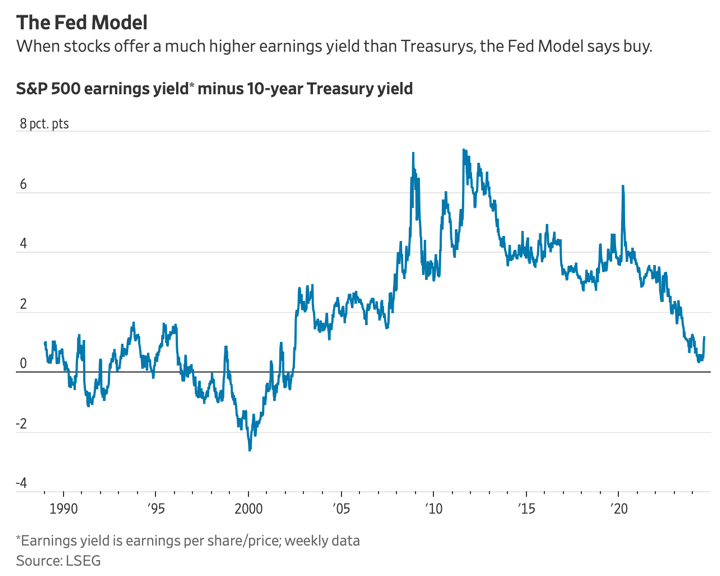US stock returns have been doing quite well, and my brokerage statement numbers keep going up. Should I be worried? Here are some ways that people try to measure whether stock valuations are cheap or expensive, along with some current numbers as of September 2024.
Quick background. Value is often said to be “what you pay” versus “what you get”. For the stock market, you divide price by earnings and get the “P/E ratio”. If a business costs $100 a share and that share earns $100 in profit every year, you get a P/E ratio of 1, which is usually considered very cheap. If another business at the same price earns only $1 per share every year, you get a P/E ratio of 100, which is usually considered very expensive. The inverse of P/E ratio is earnings yield, for example a P/E ratio of 100 is the same as an earnings yield of 1% (1/100).
Cyclically-Adjusted Earnings Yield vs. TIPS yield. CAPE stands for cyclically-adjusted price-to-earnings ratio, which basically means you use the average earnings over the last 10 years to smooth things out. Some call it PE10, or Shiller PE after Professor Robert Shiller who popularized it. This WSJ article Markets Are Way Out of Line With Reality, According to These Measures (archive) offers some nice charts about CAPE and other valuation methods. As you can see, the CAPE is pretty high right now.

I’m currently reading The Missing Billionaires: A Guide to Better Financial Decisions and they also use the CAPE and it’s inverse to offer a prediction of the future real return of the stock market:
The most popular metric for estimating the expected return of a broad stock market is known as Shiller’s cyclically adjusted price-to-earnings ratio (CAPE).a When the CAPE ratio is high, investors are paying a high price for a normalized stream of earnings, and the prospective return of the stock market is low. This finding makes logical and intuitive sense and is borne out in historical data over a long horizon.
[…] We can say something still more specific and powerful: 1/CAPE is a pretty good, though imperfect, predictor of the inflation-adjusted (i.e., real) return of the stock market over a long horizon. The measure 1/CAPE is known as the cyclically adjusted earnings yield (we’ll often shorten to “earnings yield”) because it’s calculated as earnings divided by price. If you invest in the stock market when the earnings yield is 6%, your best expectation is that you’ll earn a long-term return (after inflation) of 6%.
Here is their evidence, taken from the book:

For example, if the CAPE is 35 as of this writing, that means the cyclically-adjusted earnings yield is roughly 2.9%. That means they predict the long-term real return of the S&P 500 to ~3% as of this writing.
As a form of comparison, they suggest looking at the current real yield of TIPS: 1.7% real yield for the 10-year TIPS and 2% real yield for the 30-year TIPS. The gap between the predicted equity return and that of a “risk-free” bond is known as the (one version of) the equity risk premium (ERP). A 1% ERP is historically pretty low, but at least it is positive!
Fed Model: Current Earnings Yield vs. 10-Year Treasury Yield. Another valuation model from the WSJ article is the Fed Model, which usually takes the current P/E ratio (price divided by expected forward earnings or earnings over the last 12 months) and compares it against the traditional, nominal 10-year Treasury yield:
The Fed Model, named by strategist Ed Yardeni in the late 1990s, attempts to compare stocks with bonds by comparing the earnings yield, or earnings per share divided by price, with bond yields. It is widely used to work out whether stocks are expensive or cheap compared with the safer alternative, Treasurys. At the moment, the Fed Model suggests they are very expensive indeed. They were even more expensive a month ago, before 10-year yields fell sharply, when the S&P 500 was the most expensive relative to bonds since 2002.

You can read some criticisms of the Fed model as a predictive measure on its Wikipedia page.
Using either valuation model, you can see that the prices of US stocks relative to their earnings is high according to historical standards. Turning this observation to action is much harder. When should you jump out? When should you jump back in? How high is too high? According to the timing models suggested in The Missing Billionaires book, right now they would be only about 20% equities. I simply don’t have the confidence in the historical back-tested data to make such drastic moves in my own portfolio. My only “skill” is the lazy tendency to do nothing and letting time work things out.
 The Best Credit Card Bonus Offers – 2025
The Best Credit Card Bonus Offers – 2025 Big List of Free Stocks from Brokerage Apps
Big List of Free Stocks from Brokerage Apps Best Interest Rates on Cash - 2025
Best Interest Rates on Cash - 2025 Free Credit Scores x 3 + Free Credit Monitoring
Free Credit Scores x 3 + Free Credit Monitoring Best No Fee 0% APR Balance Transfer Offers
Best No Fee 0% APR Balance Transfer Offers Little-Known Cellular Data Plans That Can Save Big Money
Little-Known Cellular Data Plans That Can Save Big Money How To Haggle Your Cable or Direct TV Bill
How To Haggle Your Cable or Direct TV Bill Big List of Free Consumer Data Reports (Credit, Rent, Work)
Big List of Free Consumer Data Reports (Credit, Rent, Work)
I wonder how much it would change the math if you just removed Apple, Microsoft & Nvidia and their 9 trillion valuation and >30PEs?
We are likely nearing the end of a cycle here. I’ve kept my US stocks divided between total market and mid/small caps because every mega-tech cycle has a beginning, middle, and end. Look back to the railroads and steel producers of the 19th century, General Motors, General Electric, IBM, and other faded stars.
Per The Graduate (1967) “I have one word for you: Plastics”
The critical factors include: (1) whether the government gets aggressive in regulating the de facto tech monopolies — see Teddy Roosevelt and the trustbusters or various state takeovers of the 20th century, and (2) whether lower-cost competitors start to eat more and more market share over time.
I’m very good at this lazy strategy too 🙂
What do you think of the corporate buybacks set to end on September 13th? I think this has been artificially inflating stock prices for years, companies have used excess cash to buy back their own shares, which reduces the number of shares available and drives up demand and prices. Warren Buffett has already started selling off shares, which is a sign that even major investors are gearing up for a potential market decline.